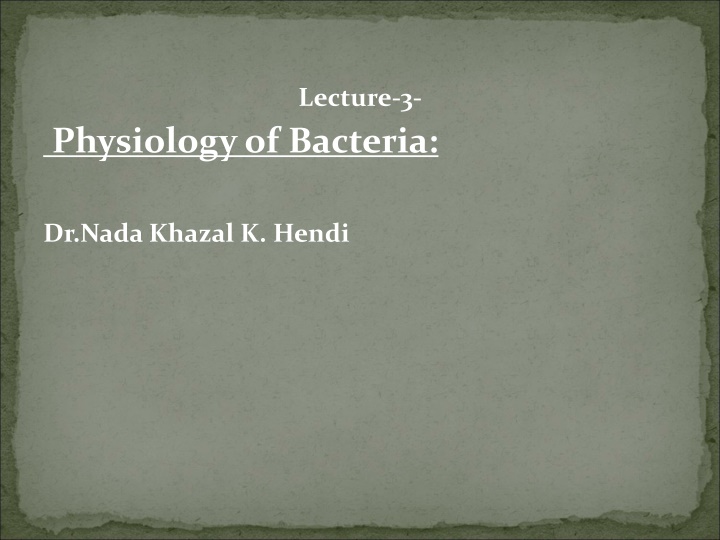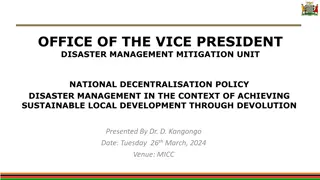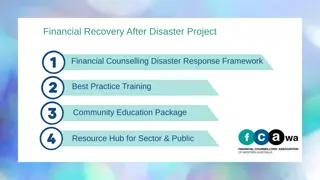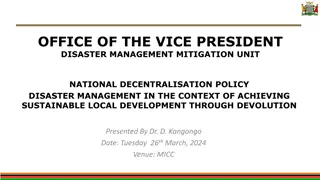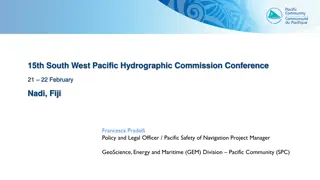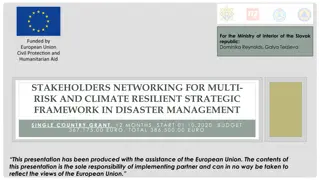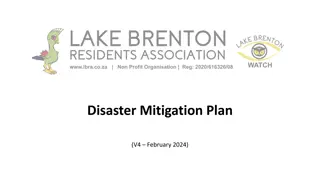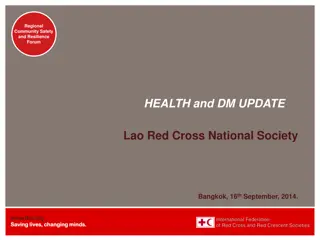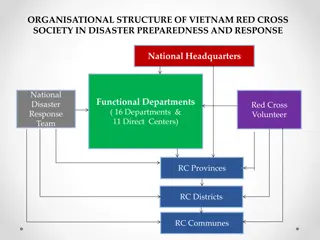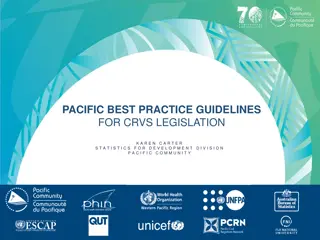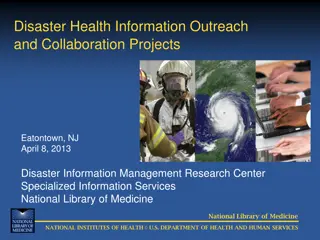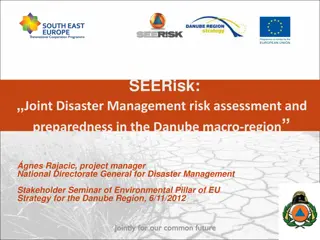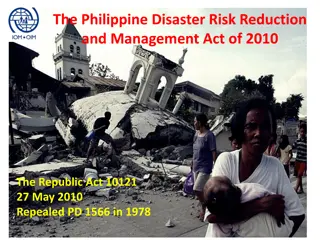Pacific Science and Technology Advisory Group: Enhancing Disaster Resilience
The Pacific Science and Technology Advisory Group (PSTAG) plays a crucial role in leveraging science and technology to achieve disaster resilience in the Pacific region. By focusing on key areas such as risk reduction, governance, and preparedness, PSTAG aims to support the implementation of the Sendai Framework for Disaster Risk Reduction. Through international and regional collaboration, PSTAG members work towards enhancing the use of scientific knowledge and technological solutions to address climate and disaster risks effectively.
Download Presentation

Please find below an Image/Link to download the presentation.
The content on the website is provided AS IS for your information and personal use only. It may not be sold, licensed, or shared on other websites without obtaining consent from the author.If you encounter any issues during the download, it is possible that the publisher has removed the file from their server.
You are allowed to download the files provided on this website for personal or commercial use, subject to the condition that they are used lawfully. All files are the property of their respective owners.
The content on the website is provided AS IS for your information and personal use only. It may not be sold, licensed, or shared on other websites without obtaining consent from the author.
E N D
Presentation Transcript
Lecture-3- Physiology of Bacteria: Dr.Nada Khazal K. Hendi
L3: Physiology of Bacteria: Bacterial growth Growth is the orderly increase in the sum of all the components of an organism. Cell multiplication is a consequence of growth, in unicellular organism, growth leads to an increase in the number of individuals making up a population. The bacterial growth can be measured by: A: cell concentration: viable cell count. B: Bio mass density: by determining the dry weight of a microbial culture. Phases of the bacteria growth: The phases of the bacterial growth curve are shown in figure:
1_lag phase:_ represents the period of adaptation to the new environment, enzymes. And intermediates are formed. 2_ log (exponential) phase:_ the number of cell increase exponentially (one becomes 2, 2 4, 4 8 ..) , the time required for this doubling is called as generation time or doubling time. 3_stationary phase:_ the exhaustion of nutrients or the accumulation of toxic products 4_ death phase:_ after the period of time in the stationary phase, and completely exhausted of nutrients and accumulation of high level of toxic substances, the death increase until it reach a steady level.
Table (3) Phase & Growth rate of the bacterial growth Phase Growth rate Lag Zero Exponential Positive constant Stationary Zero Death Negative (death)
Environmental growth factors A-Nutrients The following nutrients must be provided for any bacterial culture: 1. Hydrogen donors and accepters. 2. Carbon source. 3. Minerals elements (sulfur and phosphorus). 4. Growth factors (amino acid, pyrimidinesand purin). B-pH: bacteria can be classified according to pH rang: 1. Neutrophiles: pH=6-8. most pathogenic bacteria. 2. Acidophiles: pH=3. can grow at pH as low as 3. 3. Alkaliphiles: pH=10.5. can grow at pH as high as 10.5.
C- Temperature: bacteria can be classified according to temperature: 1. Mesophiles: grow best at 30-37 C. most pathogenic bacteria. 2. Psychophiles: grow best at15-20 C. 3. Thermophiles: grow best at 50-60 C. D- Oxygen: 1. Obligate aerobes: need O2 as hydrogen accepter. 2. Obligate anaerobes:- need substance other than O2 , and being sensitive to O2 inhibition 3. Facultative:- able to live aerobically or an aerobically. E-salt & osmotic pressure Halophiles: requiring high salt concentrations (marine bacteria). Osmophiles: requiring high osmotic pressure.
aerobic bacteria +O2 H2O2 (toxic for bacteria ) produce enzyme by bacteria (catalase) H2O+ O2 (gas bubbles) Non aerobic bacteria +O2 H2O2 (toxic for bacteria ) bacteria is not produce enzyme) H2O2
Microbiological culture media The growth of MO depends on available nutrients and favorable growth environment. The cultures media differ depend on MO needing to nutrition. The media divided depending on their contents into: 1.Natural media. 2. Synthetic media. 3. Semi synthetic media. While the media can be divided depending physical state in to: 1.Liquid media (broth). 2. Solid media (agar). 3. Semisolid media. Type of inoculation of media: 1.Streaking plate. 2. Spreading methods. 3. Pour plate technique. 4. stapping methods.
stains: are chemical compounds with colored ions which react with the different constituents of the living cell to stain the transparent and minute cells of bacteria which aredifficult to see by naked eyes. The stain may be classified into simple and differential, the simple stain colored all parts of the cell e.g. methylene blue while the differential stain are so selected that react with specific groups of the different parts of the cell or of different genera and species of bacteria for example Gram stain helps in the identification of bacteria G+ ve and G-ve especially the pathogenic agents that causing disease in the lab. Many theories have been proposed to explain the observed difference in Gram staining, one of the most common theory is that based on variation in the chemical composition of bacterial cell wall . G+ve bacteria contain magnesium- RNA-protein carbohydrate complex which form an insoluble substance with the crystal violet and iodine , this complex is not washed with alcohol , while the lipid content of the cell wall being 10 times in G-ve as much as in G+ve ones , this lead to the solubility of lipids in alcohol and increase of cell wall porosity in G-ve and crystal violet iodine complex can be extracted , so , G-ve cells become colorless after alcohol washing color safranin (cell turn pink) as shown in the below figure . and take the another
Gram stain G+ ve G-ve -crystal violet purple purple Washing after 1 mint -Iodine purple purple Washing after 1 mint -alcohol Washing after 15 sec purple -Safranin colorless purple pink Washing after 1 mint
Source of metabolic energy:_ The three major mechanisms for generating metabolic energy are fermentation, aerobic respiration, and anaerobic respiration:- 1. Aerobic respiration:- is the metabolic process in which (O2) serves as the final electron acceptor for the electron transport chain. In this process O2 is reduced to water. This is the energy- generating used by all aerobic bacteria. 2. Anaerobic respiration: - is the metabolic process in which inorganic compounds rather than O2 serve as the final acceptors, these acceptors can be nitrate or sulfate.
3. Fermentation: is an alternative aerobic process, by which an organic metabolic intermediate serves as the final electron transport, such as pyruvate, lactate, or ethanol which is released from glucose fermentation. In all pathways the energy represented by ATP is released and used in the biosynthesis of bacterial cell component (cell wall, capsule, ) the ATP yielded is much higher in respiration than fermentation.
